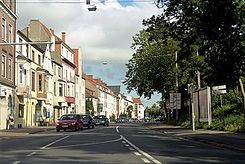Woltmershauser Strasse
| Woltmershauser Strasse | |
|---|---|
| Street in Bremen | |
| Basic data | |
| city | Bremen |
| district | Woltmershausen |
| Created | in the 17th century |
| Cross streets | Wiedhofstr., Stromer Str. Blexer Str., Kampfhofer Str., Tettenser Weg, Duntzestr ., Goosestr., Huchtinger Str., Stuhrer Str., Rechtenflether Str., Westerdeich, Ochtumstr ., Wildeshauser Str., Ahlhorner Str., Dötlinger Str ., Hempenweg, Schillingstr., Eichenstr ., Ladesstr., Huder Str., Delmenhorster Str., Akazienstr ., Zwischenahner Str., Ladesstr., Dangaster Str., Simon-Bolivar- Str., Beim Neustadtsgüterbahnhof |
| Buildings | Christ Church , Woltmershausen police station , Pusdorf cultural center |
| use | |
| User groups | Cars, bikes and pedestrians |
| Road design | two and three lane road |
| Technical specifications | |
| Street length | 2400 meters |
The Woltmershauser street is a historical street in a north-south direction in Bremen in the district Woltmershausen . It leads from the street in the district Rablinghauser Rablinghausen to Oldenburg road ( B75 ) / Am Hohentorsplatz in the New Town .
The cross streets were u. a. Named as Wiedhofstraße after a farm owner, Kampfhofer Damm after a hallway and farm name, Goosestrasse after a hallway name ( Goosekamp = Gänsekamp ), Westerdeich (there was also an Osterdeich), Hempenweg (hallway name), Schillingstrasse after a family and loading street after the neighboring loading areas at the port; otherwise see the link to the streets.
Woltmershauser Straße is the street with the third highest house number (No. 574) in Bremen.
history
Surname
The street was named after the Woltmershausen district, which was named after a former landlord named Woltimar ( Woltmer ).
development
Woltmershausen's few houses were burned down by order of the Bremen council in 1666 in order to maintain a clear field of fire against the advancing Swedes. The village had around 300 inhabitants in the 18th century. In the 19th century, shipbuilding was carried out on the left bank of the Weser , and sawmills and planing mills were located there. Shops, inns and businesses were now developing on Woltmershauser Strasse.
The municipal cemetery Woltmershausen dates from 1890. Woltmershausen became a part of Bremen in 1902. The historicizing Christ Church was consecrated in 1906 and the police station in 1910.
During the Second World War, there were some building losses on the street due to bombs.
In 1982, with the opening of the culture shop in Pusdorf an der Straße, social and cultural work received new impulses. In 2000 the Kulturhaus moved and uses two floors in the Kulturhaus Pusdorf.
traffic
From 1901 to 1903 a tram line was built from the city center to Woltmershauser Straße. Line number 7 was introduced in 1908. This tram line was continued to Rablinghausen-Bakeweg in 1933. In 1965, tram line 7 was closed.
In transport in Bremen since the bus runs on this road 24 (Rablinghausen - Domsheide - Central Station - Neue Vahr-Nord).
Buildings and facilities
On the street there are one, two, three and four-story buildings, most of which are residential buildings, and in the central areas commercial buildings and the halls of commercial enterprises.
- No. 71: 2-sch. Police station XV from 1910 based on plans by Hans Ohnesorge , later 11th police station in Woltmershausen
- No. 376: Evangelical neo-Gothic Christ Church from 1906 based on plans by the architects August Abbehusen and Otto Blendermann
- Nearby: Westerdeich 146 farmhouse
Other buildings and facilities worth mentioning are:
- No. 66: 4-sch. Commercial and residential building
- No. 70ff and Ladestraße: commercial operations (including Lauprecht, Brinkkötter, BreLay, Niemet, Gluud)
- No. 152: Bunker with wall painting
- No. 261: Kino Die Blende from 1956 to around 1962
- No. 266: 3-sch. House for the elderly care
- at 286: small Pusdorf market square
- No. 298: 1-gesch. Protestant Free Church Woltmershausen
- No. 310: 3-sch. A meeting place for the elderly
- No. 348: 4-gesch. Residential and banking house with the Sparkasse Bremen branch
- Nt. 442: Thalia cinema around 1921
- No. 444: 3-sch. Kulturhaus Pusdorf from 2000
- No. 476: Wolmershausen municipal cemetery from 1890 on 3.2 hectares with a neo-Gothic chapel
- 530–538 or 369–397: green area with allotments
Art in public space
- General: Color coding system by Peter Vogel from 1977
- Paths to the Weser , project from 2001 with the participation of Rolf Gesing, Herwig Gillerke, Maike Hartwig, Henrik Jacobs, Ralph Kull, Ilze Orinska, Barbara Rosengarth, Kai Thies
- No. 408: Leaf catcher made of bronze by Andreas Wegner from 1985
- No. 152: The all-busting run of money , mural 10 mx 30 m by Jimmi D. Paesler from 1978
- No. 174: Nostalgia , mural by Jub Mönster from 1987
- No. 241: Mural by Birgit Hansen and Gerhard Schlueter from 1988
- Woltmershauser Tunnel: wall painting by Jub Mönster
See also
literature
- Herbert Black Forest : The Great Bremen Lexicon . 2nd, updated, revised and expanded edition. Edition Temmen, Bremen 2003, ISBN 3-86108-693-X (first edition: 2002, supplementary volume A – Z. 2008, ISBN 978-3-86108-986-5 ).
- Monika Porsch: Bremer Straßenlexikon , complete edition. Schünemann, Bremen 2003, ISBN 3-7961-1850-X .
Individual evidence
- ^ Weser-Kurier dated February 26, 2017.
- ↑ Kulturhaus Pusdorf
- ^ Art in public space in Bremen
Coordinates: 53 ° 4 ′ 56 ″ N , 8 ° 46 ′ 13 ″ E



